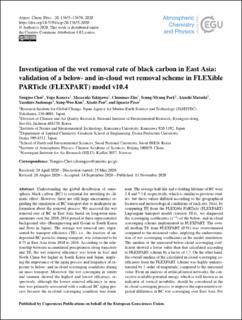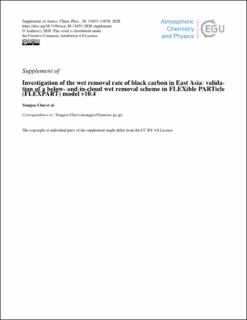| dc.description.abstract | Understanding the global distribution of atmospheric black carbon (BC) is essential for unveiling its climatic effect. However, there are still large uncertainties regarding the simulation of BC transport due to inadequate information about the removal process. We accessed the wet removal rate of BC in East Asia based on long-term measurements over the 2010–2016 period at three representative background sites (Baengnyeong and Gosan in South Korea and Noto in Japan). The average wet removal rate, represented by transport efficiency (TE), i.e., the fraction of undeposited BC particles during transport, was estimated to be 0.73 in East Asia from 2010 to 2016. According to the relationship between accumulated precipitation along trajectory and TE, the wet removal efficiency was lower in East and North China but higher in South Korea and Japan, implying the importance of the aging process and frequency of exposure to below- and in-cloud scavenging conditions during air mass transport. Moreover, the wet scavenging in winter and summer showed the highest and lowest efficiency, respectively, although the lowest removal efficiency in summer was primarily associated with a reduced BC aging process because the in-cloud scavenging condition was dominant. The average half-life and e-folding lifetime of BC were 2.8 and 7.1 d, respectively, which is similar to previous studies, but those values differed according to the geographical location and meteorological conditions of each site. Next, by comparing TE from the FLEXible PARTicle (FLEXPART) Lagrangian transport model (version 10.4), we diagnosed the scavenging coefficients (s−1) of the below- and in-cloud scavenging scheme implemented in FLEXPART. The overall median TE from FLEXPART (0.91) was overestimated compared to the measured value, implying the underestimation of wet scavenging coefficients in the model simulation. The median of the measured below-cloud scavenging coefficient showed a lower value than that calculated according to FLEXPART scheme by a factor of 1.7. On the other hand, the overall median of the calculated in-cloud scavenging coefficients from the FLEXPART scheme was highly underestimated by 1 order of magnitude, compared to the measured value. From an analysis of artificial neural networks, the convective available potential energy, which is well known as an indicator of vertical instability, should be considered in the in-cloud scavenging process to improve the representative regional difference in BC wet scavenging over East Asia. For the first time, this study suggests an effective and straightforward evaluation method for wet scavenging schemes (both below and in cloud), by introducing TE along with excluding effects from the inaccurate emission inventories. | en_US |


